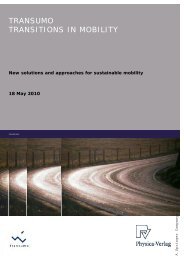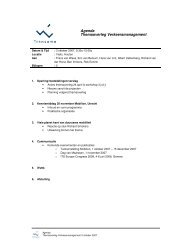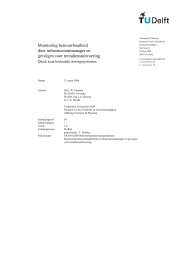Casestudie Breakdown prediction Contell PILOT - Transumo
Casestudie Breakdown prediction Contell PILOT - Transumo
Casestudie Breakdown prediction Contell PILOT - Transumo
Create successful ePaper yourself
Turn your PDF publications into a flip-book with our unique Google optimized e-Paper software.
The mode is the most frequent value of a dataset. It can be regarded as a kind of<br />
center of a sorted dataset ([Eckey02], p. 42). Therefore, the mode is suitable to get a<br />
quick overview of the main behavior of large datasets. A disadvantage of the mode is<br />
the ignorance of outliers.<br />
The median is a value that divides a dataset into two parts of same extend. To<br />
calculate the median the single values of the given dataset have to be sorted by size<br />
to a row, so that X<br />
( 1)<br />
≤ X<br />
(2)<br />
≤K ≤ X<br />
( n)<br />
is complied. Afterwards, the value right in the<br />
middle is the median. In case of an even number of values, the mean of the two mid<br />
values is taken as described by the following Formula 5-1: ([Eckey02], p. 44)<br />
X<br />
⎧X<br />
(( n+<br />
⎪<br />
= ⎨1<br />
⎪ ( X<br />
⎩2<br />
1) / 2)<br />
( n / 2)<br />
+ X<br />
( n / 2+<br />
1)<br />
)<br />
if n odd<br />
if n even<br />
Formula 5-1: The Median Formula<br />
In case of a normal distribution, mode and median are very similar. This behavior<br />
changes, if the most frequent temperature value tends to one of the interval borders.<br />
Moreover, the median also ignores outliers.<br />
Probably the most common value in statistics is the mean. In fact, several different<br />
types of mean values do exist. Talking about the mean generally just denotes the<br />
arithmetic mean. It is calculated by just summarizing all values from a dataset and a<br />
subsequent division by the dataset’s quantity. Formula 5-2 describes this procedure<br />
in mathematical form. In contrast to mode and median, the arithmetic mean does not<br />
ignore outliers but weights every single value the same. ([Bourier03], p. 79)<br />
X<br />
1<br />
=<br />
n<br />
n<br />
∑ X i<br />
i=<br />
1<br />
Formula 5-2: The Arithmetic Mean Formula<br />
As already mentioned, there are several different mean values. Beside the already<br />
introduced arithmetic mean, there are the geometric and the harmonic mean. The<br />
geometric mean is especially used to analyze growth rates ([Bourier03], p. 84). The<br />
harmonic mean is defined to provide mean values of ratios ([Eckey02], p. 54). As<br />
monitoring data within the setting of sensor based temperature monitoring is neither<br />
faced with growth rates nor ratios these methods will not be presented.<br />
59
















